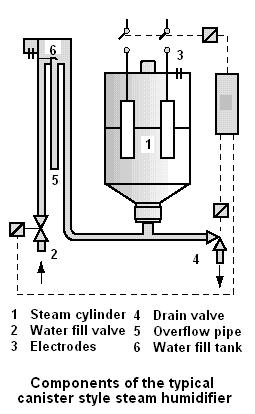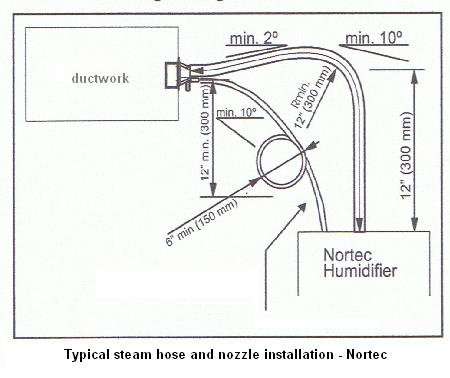- Home
Company PagesInformation PagesSite Blog
|
|

|

STEAM HUMIDIFIERS
Basic Installation and Servicing the Most Common Styles

A very common style of steam humidifier is the canister type, or steam cylinder type. This type has a canister in the humidifier with electrodes inside, where the steam is produced.
On a call for humidity, current flows through the water between the electrodes. Minerals in the water provide conductance and
resistance for electric flow, and steam is produced. Then the steam rises out of the canister and is distributed through a steam hose into the forced air ductwork for distribution, or to a through-wall fan pack for direct room distribution.
Some manufacturers of the canister type humidifier:
Nortec
GeneralAire
Carel
Important points about to ponder about steam humidifiers
- If your primary heating source for your home is radiant, the steam humidifier is the best option to humidify your home. An evaporative type (bypass or powered flow-through) does not perform well without a heated air stream for delivery.
- The canisters in this type of humidifier need replacing approximately once per year. Depending upon the hardness of your water, it could be more often. The cost of a replacement cylinder ranges from $75.00 on up, plus service call fees if you hire your service done.
Installation procedure for the canister type steam humidifier
- Remove the front cover, remove the steam cylinder.
- Mount the humidifier. The unit should be located as close to the ductwork or the remote fan unit as possible to minimize condensate. Mount the unit on a wall. Do not mount the unit on any vibrating surface, such as the air handler or ductwork.
- Locate, cut in, and install the steam distribution nozzle into the ductwork above the humidifier whenever possible, or locate the position of the remote through-wall fan unit.

- Install the steam hose. Slope must be maintained in the
steam hose. Avoid kinks and low spots, which can trap condensate and cause future problems.
- Install the nozzle drain hose. This small hose usually drains back to the humidifier. Be sure to maintain slope and to trap the hose as per manufacturer's recommendations.
Consult your installation directions often. Certain clearances must be maintained for maintenance access.
- Connect water feed. Most units require a 1/4" water line hook up at the unit. Self piercing saddle valves are often used, but are best replaced with a standard 1/2" ball valve, and run a 1/2” water line to within 3 feet before reducing to 1/4” OD for the final connection.
NOTE: Use potable water only. Water conductivity should range between 125 and 1250 micromhos. If water conductivity exceeds 250 micromhos, do not use softened water. Demineralized
water should never be used, because there are no minerals to conduct the electricity.
- Connect water drain. The drain line from a steam humidifier must be trapped immediately upon exiting the unit to prevent steam from rising out of the drain pipe and condensing
inside the humidifier unit.
Some steam humidifiers require a large 1 1/2” O.D. plastic drain pipe. Others require only a 1" or a 3/4" CPVC drain line. Consult your installation directions.
WARNING: Drain water can be up to 200°F, hence the use of CPVC instead of standard PVC piping.
- Connect Power Wiring. Refer to the manufacturer's recommended wiring schematics and follow them carefully. Each different brand of steam humidifier has it's own unique characteristics and requirements. An external disconnect should be field provided by the installer.
A Nortec "ResDelux" unit can be wired for either 120 volt or 240 volt. This will affect the humidity output. The Nortec requires both a common and a ground lead for the 240 volt unit.
A GeneralAire unit is common 240 volt high voltage wiring.
The Honeywell "TrueSteam" unit is standard 120 volt wiring, but be aware of reduced output in comparison to the 240 volt models. - Install low voltage wiring. The typical steam humidifier control wiring system includes a wall or return humidistat, a high limit duct humidistat, and an air proving switch. (Refer to manufacturers recommendations).
Placement of these controls is critical for proper operation of the system.
If an airflow switch (sail switch) is used, it must be positioned to accurately open on a loss of air flow, to prevent the humidifier from running when there is no air to absorb the moisture.
The hi-limit control must be far enough down stream of the steam distributor pipe to prevent it from getting wet, but still allow it to accurately prevent overhumidification of the ductwork.
Other types
On this page we have dealt mostly with canister (cylinder) type steam humidifiers. The brands and type we have mentioned are certainly not the only brands and type of steam humidifier out there on the market!
Not all require replacement of a canister annually. Some have slightly different methods of producing steam, but the installation methods are very similar to those we have outlined here.
The Honeywell "TrueSteam" mentioned and pictured above does not contain a canister inside. Nor does the Aprilaire 1160 pictured on our main humidification page.
The Honeywell "TrueSteam" may also be mounted directly to ducting (unlike most steam humidifiers). It may also be mounted remotely with a hose and nozzle kit.
Fan packs
Most steamers can be outfitted with a fan, or blower, pack for through wall distribution of humidification. The fan pack can also be located away from the unit, and connected with steam hoses. This option allows for the humidity to be dispersed up high, and yet the unit itself can be mounted lower for better servicing.
Leave Steam Humidifier page and Return to our main Humidification page
Return to HOME

Please feel free to link to this page from your website. This page's URL is: http://www.perfect-home-hvac-design.com/steam-humidifier.html
Enjoy this page? Please pay it forward. Here's how...
Would you prefer to share this page with others by linking to it?
- Click on the HTML link code below.
- Copy and paste it, adding a note of your own, into your blog, a Web page, forums, a blog comment,
your Facebook account, or anywhere that someone would find this page valuable.
| |








